
Something I am focusing on for the new year is upping my protein content. As a FODMAP aware pescatarian but mostly vegetarian, it can be difficult to get enough protein in. Add in the fact that I am testing baking recipes all day and my life is a recipe for a low protein intake (which my Doctors can attest to). So! I thought it fitting that one of the first recipes I share this year is this gluten free high protein bread.
Gluten free high protein bread recipe
Before we dive in, a quick note. This bread is best as toast – it bakes up in an ever so slightly cakey sort of fashion. I have it toasted every morning.
This gluten free high protein bread recipe is simple and easy to make. It uses a whopping 500g of cottage cheese which is blended with water (so you won’t even know it’s there, I promise!).
The flour is, of course, buckwheat flour. Simple to use and easy to bake with, buckwheat flour also contains a nice hit of protein. Combine that with the cottage cheese and you’re setting yourself up very nicely for the day.
The remaining ingredients in this high protein bread are the usual suspects. Salt for flavour, yeast for leavening, psyllium husk powder for binding. Maple syrup for a flavour boost (and food for the yeast) and a little bit of oil for a delicious soft crumb.
This bread is nut free, egg free and contains no added xanthan gum (a caveat to this, discussed in the recipe note section). It’s a simple and delicious bread that makes great toast and will keep you full until lunch.
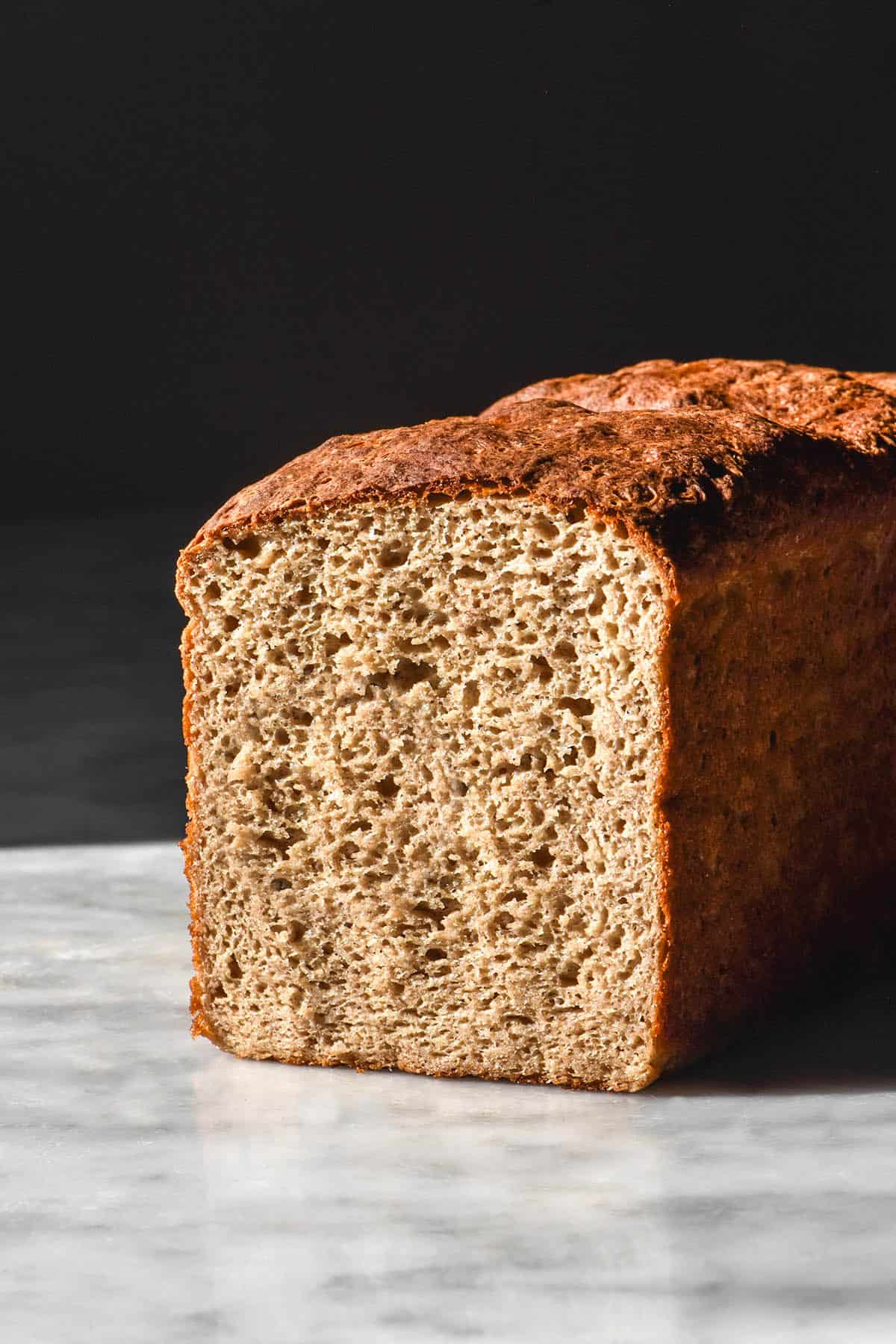
How much protein does this bread contain?
Each slice of bread contains approximately 10g of protein. That means that two slices of toast contains 20g of protein, which is a fantastic start to the day. It will help keep you feeling full until lunch and is the easiest way I have discovered to get protein in without feeling bored with it.
You can also add in some extra protein by adding 30g hemp seeds after the first proof.
Protein breakdown:
- 500g of cottage cheese with 12g protein per 100g = 60g
- 500g buckwheat flour (I used Coles brand which has 12.7g protein per 100g) = 63.5g
- 12 slices divided by 123.5g protein = 10.2g protein per slice
- Bonus 30g hemp seeds = 13g protein, bringing the total per slice to 11.3g protein per slice.
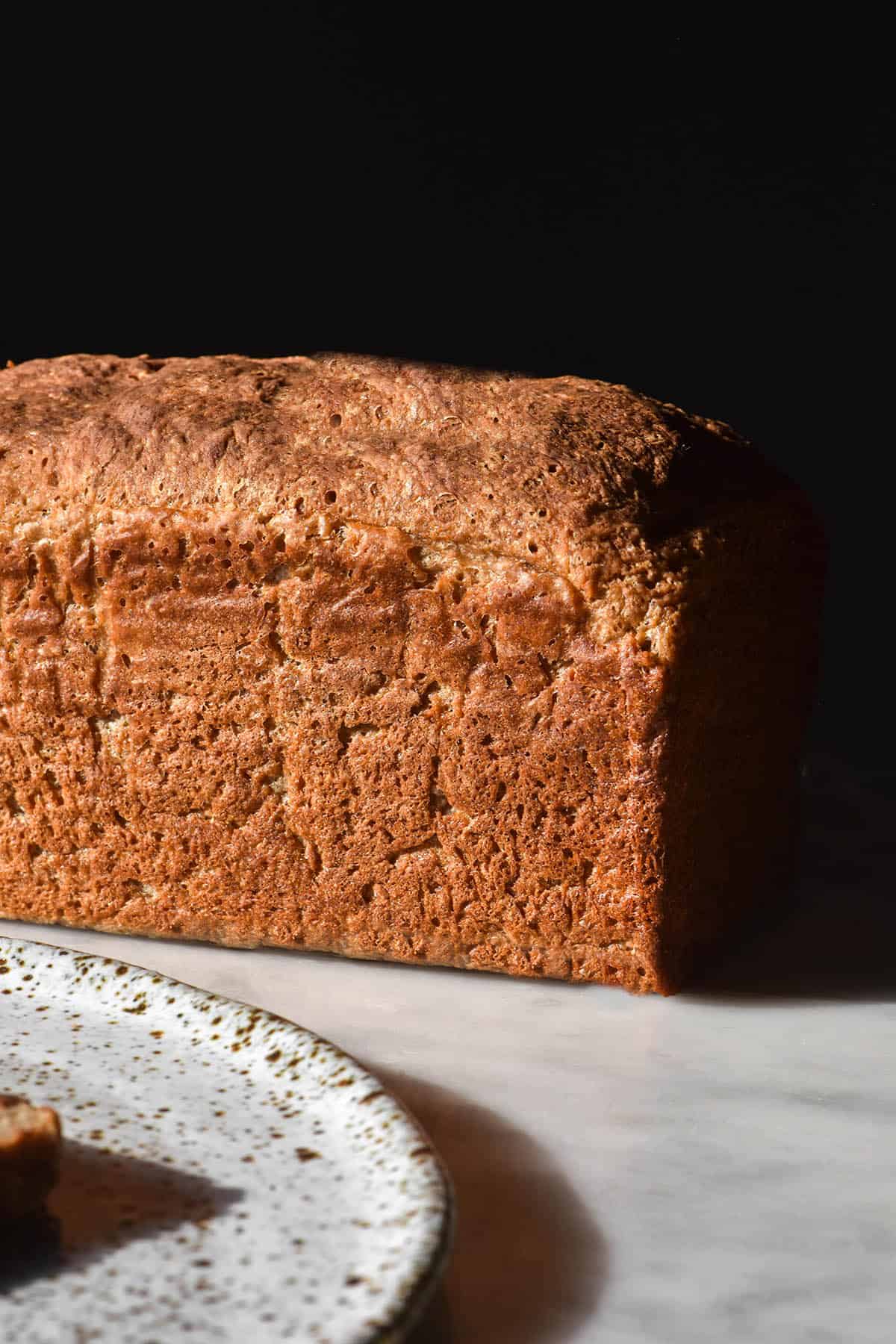
Is cottage cheese gluten free?
Yes, cottage cheese is generally always gluten free. Cottage cheese is made from milk, an acid or a rennet (which is most often non-animal) and perhaps some cream and salt. If you are catering to a coeliac, read the labels and buy a plain variety as opposed to flavoured. Gluten contamination is a higher risk when additives like jam are mixed in.
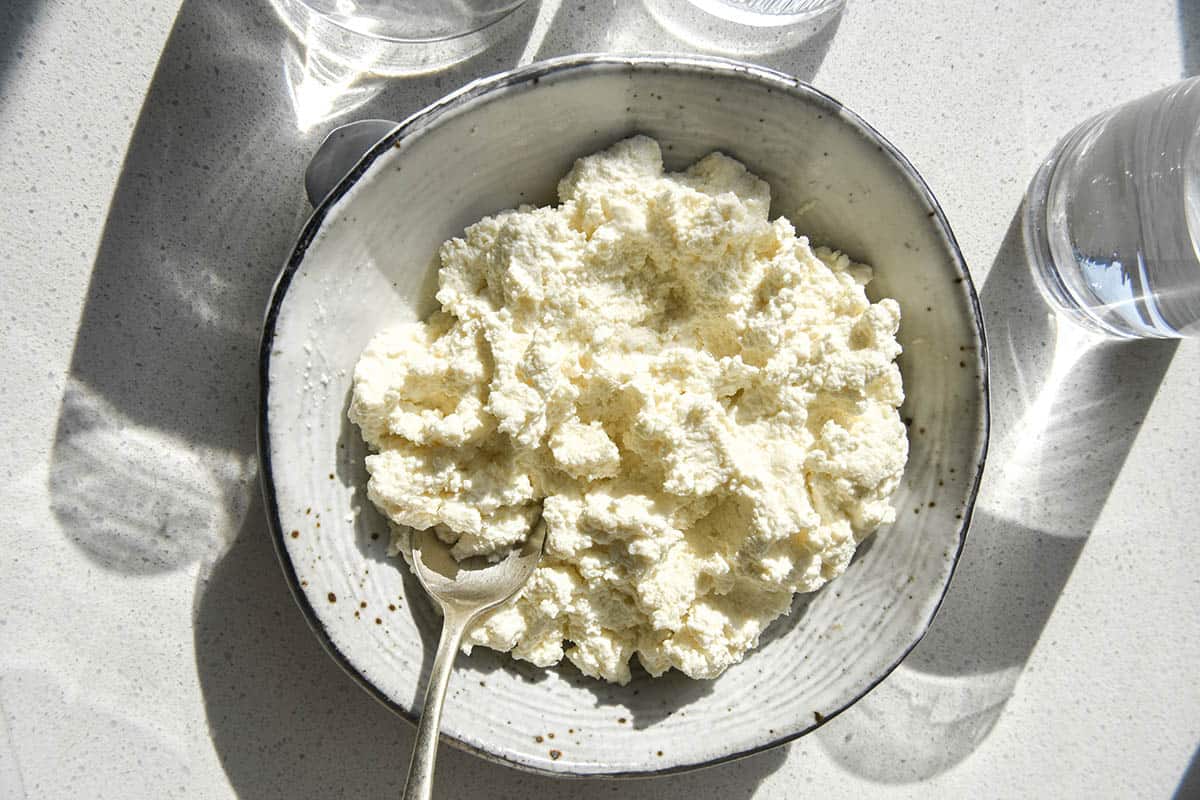
Recipe notes for the cottage cheese
My first and most important note pertains to the claim that the bread is xanthan gum free. It is, but there is a caveat. Most store bought cottage cheese brands in Australia use xanthan gum and guar gum in their product. This means that your loaf will contain some xanthan gum (how much, I can’t say) if you use these brands of cottage cheese.
In Australia, Barambah Organics make cottage cheese without xanthan gum or guar gum. Read the labels or Google to find a xanthan gum free brand where you live if you need it to be xanthan gum free.
Another option, of course, is to make your own cottage cheese (I have a lactose free recipe here). It’s a relatively simple process that uses milk, lemon juice or vinegar, salt and perhaps some cream if you’d like it to be creamier.
Homemade cottage cheese doesn’t have the same defined lumps as store bought. I would say they are a result of the xanthan and guar gums. However, this recipe blends the cottage cheese anyway, so it’s the perfect place to use it.
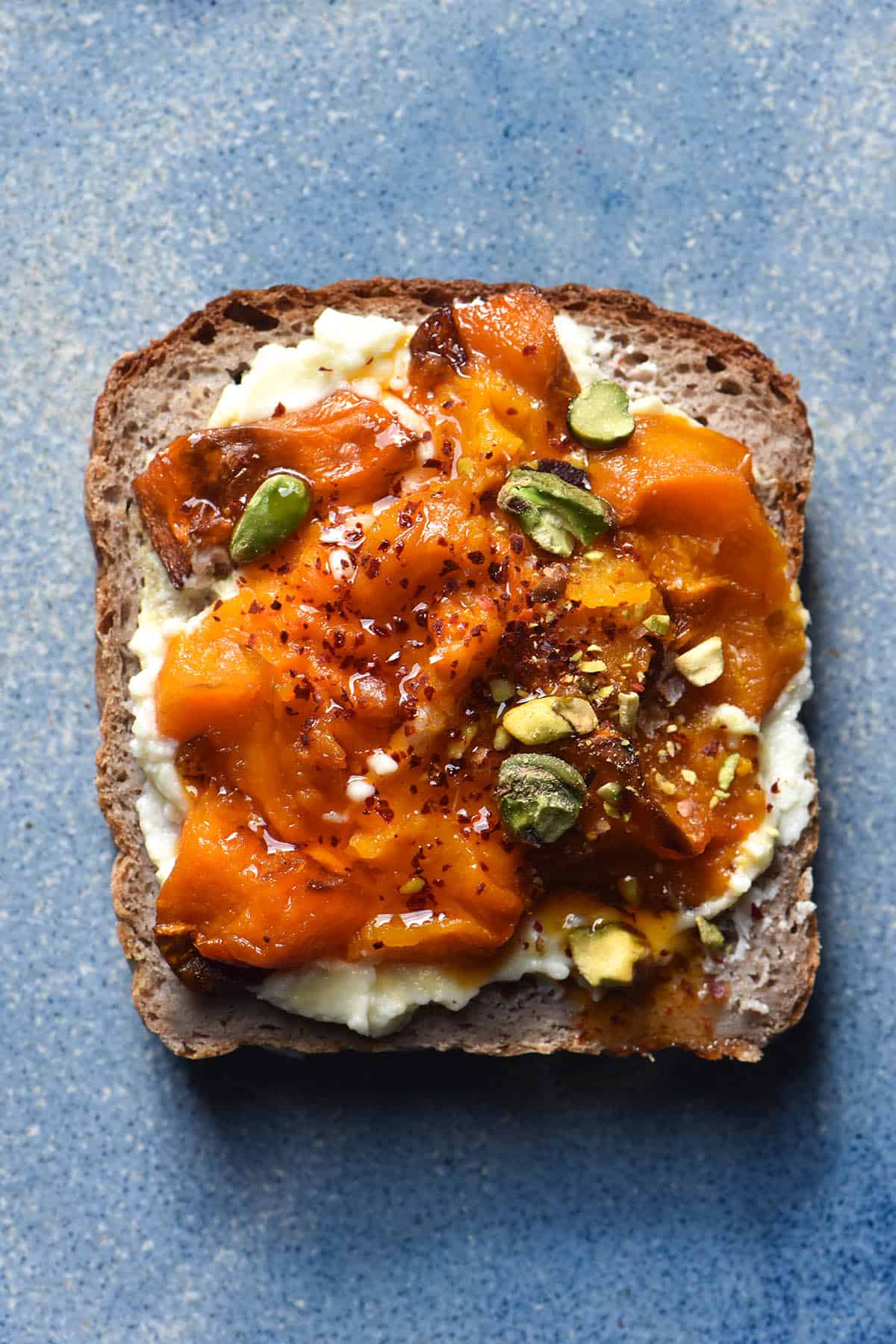
FODMAP notes for your gluten free high protein bread
The main ingredient up for FODMAP consideration in this recipe is the cottage cheese. Regular store bought cottage cheese is only low FODMAP in 40g serves per person. This is due to the lactose content of cottage cheese. Of course, if lactose is not an issue for you then there is no issue. If it is, however, you have a few options.
Firstly, buy lactose free cottage cheese. This is available at a number of supermarkets in Australia. It is more expensive and can sometimes be trickier to find, but it does exist.
If you’re not keen to pay more for what is essentially the same product: make your own. I have a recipe for lactose free (not dairy free) cottage cheese here. You can also take this a step further and make your own lactose free milk, too. This gives you control over the milk you use and will also be cheaper in the long run. NB: this method also works for cream.

Substitution options (or lack thereof)
This bread has no substitution options, sorry! Each ingredient has been specifically chosen for it’s protein content and gluten free status. The remaining players (yeast, psyllium husk powder, maple syrup and oil) support the star ingredients to ensure a successful bread.
I have not tested a yeast free option or a version without psyllium husk powder.
Unfortunately, there is no vegan cottage cheese that has a low FODMAP option and is also high protein. I have, however, developed a vegan version of this recipe that uses cannellini beans.
All this to say: while I don’t have high protein options for these requests, I do have bread recipes that cater to some of these requirements.
- Gluten free buckwheat bread recipe that is naturally vegan
- Gluten free vegan buckwheat bread recipe with pumpkin and seeds
- A yeast free, gluten free buckwheat bread in Intolerance Friendly Kitchen
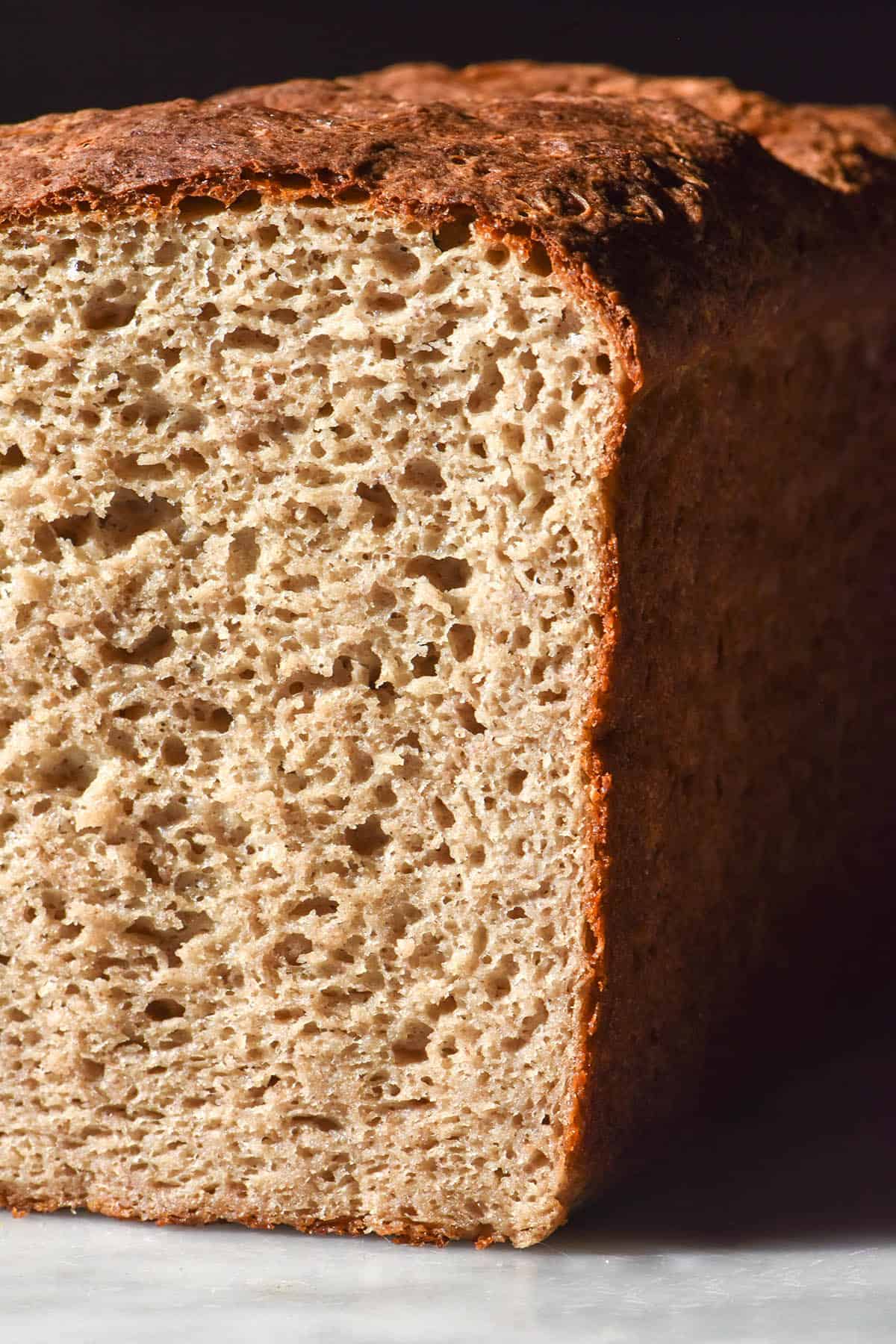
Important notes
As we have discussed, this bread is best as toast. It is slightly cakey in a way that suits toast far better than a sandwich.
That said, the more liquid you add (to an extent) the more ‘bread like’ it will be. If you really want to eat this bread fresh, I recommend using 450g total water (instead of 400g).
Secondly, a note on the salt. Cottage cheese does contain salt, so it’s up to you if you would prefer to add more. I find it does need more salt, but when you toast it and add toppings you won’t really notice. Do what works best for you.
I have found that some cottage cheese tends to have a slightly bitter aftertaste when baked. I don’t know why, but it’s not dangerous or anything. Again, you can’t taste it once you top your toast.
The baking soda (not powder) is added to try and counteract any bitterness. It also produces a loftier loaf, but introduces the possibility for the loaf browning too quickly. To counteract this, we bake the loaf solo for the first 30 minutes, then with foil for the second 30 minutes.
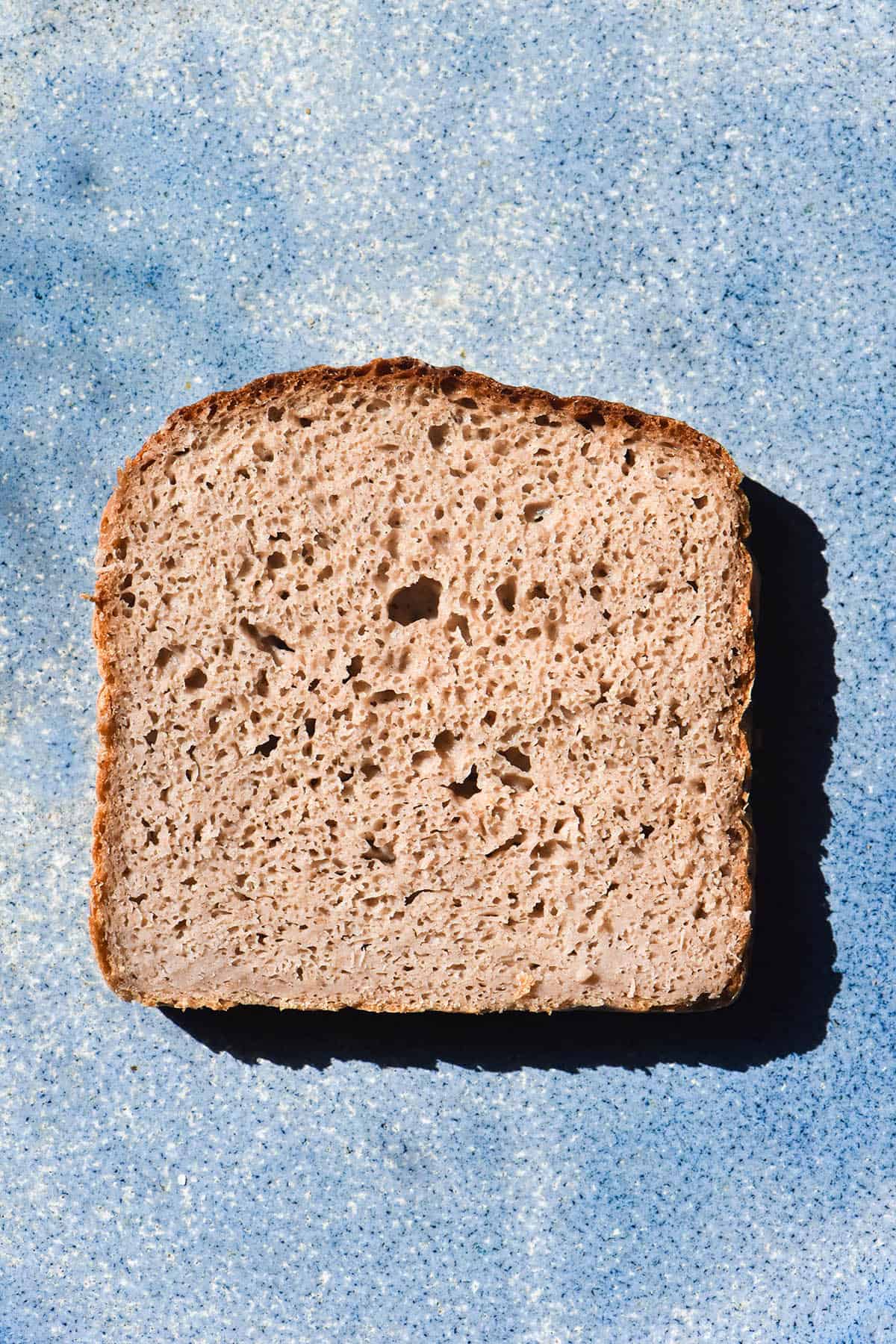
More gluten free bread recipes
- Gluten free sourdough bread
- Rice flour free gluten free sourdough bread
- Gluten free flatbreads without yeast
- Grain free white bread without xanthan gum (nut free)
- Gluten free seeded pumpkin loaf
- 100% buckwheat flour fruit toast
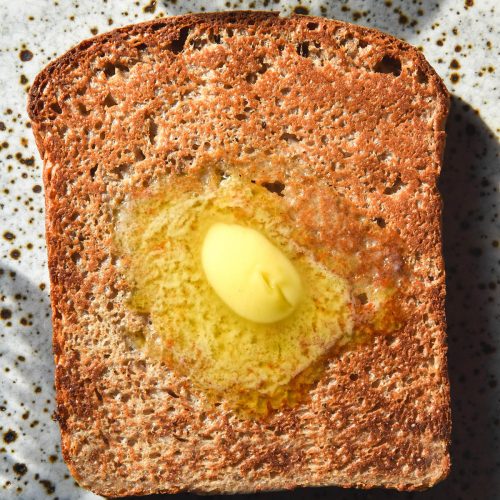
Gluten free high protein bread
Equipment
- 10 x 10 x 23 cm steel bread pan (see notes)
Ingredients
For the loaf:
- 500 g light buckwheat flour
- 25 g psyllium husk powder
- 7.5 g (1 sachet)* instant yeast
- 1/4 teaspoon baking soda
- 5 g fine salt see notes
- 200-250 g extra water
For the blended mixture:
- 500 g cottage cheese see notes
- 200 g water
- 60 ml (3 tablespoons)* neutral oil (I used vegetable)
- 40 ml (2 tablespoons)* maple syrup or honey
Instructions
- Whisk the dry ingredients for the loaf in a large non-reactive (plastic or glass) mixing bowl. Weigh out the water for the loaf in a glass and set aside.
- Combine the ingredients for the blended mixture in your blender and process until combined.
- Pour the blended mixture into the dry ingredients. Pour the measured out glass of water into the blender and shake it (lid on) to pick up all of the blended batter, then pour this extra liquid into the dry ingredients.
- Use a whisk to combine until a smooth, thick batter forms. It should be very sticky but hold it’s form.
- Cover the bowl and leave on the bench to proof for 60 minutes.
- Grease and line a 10 x 10 x 23 cm steel loaf pan. After the 60 minutes are up, carefully decant the batter into the loaf pan and use a wet hand to flatten and smooth the top. Cover the loaf and proof for another 60-90 minutes or until it has reached the top of the loaf pan.
- 30 or so minutes before the loaf is proofed, place one oven rack right at the top of your oven, and one at the bottom. The top rack will house a piece of foil to prevent the loaf from over browning in the second half of baking. The bottom rack will house the bread.
- Preheat the oven to 180C/356F.
- When the loaf is proofed, place it in the oven for 30 minutes. After this time, place the sheet of foil on the top rack and bake for another 30-40 minutes or until golden brown and firm to the touch.
- Allow the loaf to cool for 15-20 minutes in the tin before carefully removing to place on a cooling rack. Allow to cool before slicing.
- This bread is best as toast and keeps well in the fridge for a number of days. You can also slice the bread and toast it straight from frozen.
Notes
- I use a size small Pullman steel bread pan for all my loaves. A silicon pan or any short pan is not appropriate here, nor is a larger Pullman. This recipe has been designed with this pan, and using a different one will achieve an unknown result. Steel is the only pan appropriate for bread as it holds the bread while it proofs upwards.
- Use lactose free cottage cheese for a low FODMAP option. For a vegan option, see my version with cannellini beans instead (it has a Low FODMAP threshold).
- Cottage cheese already contains salt. If you’re watching your sodium levels you can omit the salt in the loaf, but it will taste a little bland.
- This recipe is developed to be toast rather than sandwich bread.
- I have found some cottage cheese bakes up bitter. This isn’t harmful and you shouldn’t taste it when you top your toast.

Hello! I’m so excited to try this as my GF daughter and I are trying for more protein in the new year too! I notice you discuss baking soda in your notes, but I don’t see it in the recipe. Am I missing it? Thank you!
Hi Katie, you’re right! Apologies, I have added it in now. Thank you for alerting me 🙂
I couldn’t find the nutritional info other than protein content. Calories, carbs, fibre?
Thanks.
I don’t calculate nutritional information for personal reasons. If you’d like to, there are plenty of free calculators online 🙂
YUM! This is so delicious. Makes beautiful, firm toast. Keeps really well in the freezer – I take a piece out the night before so that it’s ready for toasting in the morning. Delish!
Hi there,
Thanks for sharing this recipe.
What size pullman loaf tin did you use?
Also can I use olive oil?
Thanks looking forward to your reply.
Hi Angela,
The measurements for the Pullman are in the recipe card – 10 x 10 x 23 cm – which is a small USA pan Pullman. I use it for all my gluten free loaves because it’s big but small, if that makes sense. The ideal size for gluten free dough.
Olive oil will work in this recipe 🙂
Hi Georgia,
I would like to make the bread more for sandwichs, any suggestions?
Bernie Lewis
Vancouver,WA
Hi Bernie! Would you like a high protein recipe or just a gluten free bread recipe?
I have a recipe for high protein bagels which would make for a better ‘sandwich’ – https://georgeats.com/recipes/gluten-free-high-protein-bagels/
Alternatively, my buckwheat bread recipe is good for sandwiches (I recommend using light buckwheat flour as the darker buckwheat flour doesn’t have as much elasticity) – https://georgeats.com/recipes/gluten-free-buckwheat-bread/
I have a gluten free seeded bread recipe which is great for sandwiches – https://georgeats.com/recipes/gluten-free-seeded-bread-no-xanthan-gum/
If you’d like a white bread style, my grain free cassava flour – https://georgeats.com/recipes/grain-free-vegan-bread-without-xanthan-gum/
Hopefully this helps! 🙂